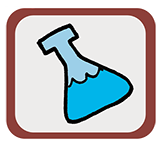For a complete introduction and to get to know each Fuddlebrook story/concept, work your way across the main menu bar above. Have fun exploring, and please contact us with any questions you may have!
But that's not all. Check out the introductory video that explains why we created the Fuddlebrook School Science Series.

Summertime offers all sorts of opportunities for fun science. This month we explore our amazing organ, skin! Of course in the summer it’s also important to protect it from harmful ultraviolet rays with a good sunscreen.

Amaze your friends with this science “trick” that also teaches about the center of gravity. Who knew an empty soda can and some water could provide such fun!
It’s summertime. That means longer days and being outside. It’s also time for us to use sunscreen to protect our skin. In the classic book Freckle Juice by Judy Blume, Andrew wishes he had freckles. He thinks that, if he had freckles, his mom wouldn't know if his neck was dirty and he wouldn't have to wash it! Read that and then compare it to the Fuddlebrook book, A Bad Case of the Spots, where Freddie is not so sure about his “spots.” Follow along as Bert plays a joke on Freddie and convinces him that those spots are terrible and will keep him away from friends and summer activities! Of course Mrs. Wigglebum steps in to save the day (and explain the science of ultraviolet rays and their effects on our skin).
But that’s not all we need to protect. Also read the Fuddlebrook story, The Eye’s Have It, to learn about the wonder of our eyes and ways to protect them from the Sun’s rays, too.
Enjoy learning more about our skin in our fun video where Gabby and Hallie make an edible skin model that also serves as a yummy treat. Or make this sweet treat we found online, Frosted Freckled Lemonade. Enjoy your cool drink while soaking up the hot rays of the Sun (with sunscreen protection of course)! Ahhh…here’s to summer!
Legend has it that Sir Isaac Newton formulated his theory on gravity in the 1660’s after watching an apple fall from a tree. It’s one of the most famous anecdotes in the history of science! But what is gravity? Objects with mass are attracted to each other. And that’s gravity! For example Earth pulls on us and keeps us on the ground. The Sun's gravitational pull keeps our planet orbiting the Sun. The Moon's gravity pulls on the Earth and makes the tides rise and fall every day. In the book A Case of Gravity, Liza learns a “painful” lesson about gravity.
There are also two awesome activities in this book that demonstrate concepts of gravity. Watch the kids in our video have a whole lot of fun with The Mysterious Leaning Can Investigation. Also watch as they try The Fuddlebrook Bottle Drop.
So what’s the science question with the bottle drop? Do objects fall at the same speed even if they don’t have the same mass? Credit Italian scientist Galileo Galilei who is said to have tried dropping two objects of different weights from the Leaning Tower of Pisa, to find the answer to this question.
And Galileo, like our children, found the answer to be yes. This is called the equivalence principle. Objects of different masses will fall to the Earth at the same speed. Want another cool demonstration of this? Check this out. https://www.youtube.com/watch?v=E43-CfukEgs
Galileo’s work disproved the earlier work of Aristotle that suggested that heavier objects fell faster than lighter ones. As for Galileo's interest in disproving Aristotle's theory about falling objects, years later he said that he had first thought about this during a hailstorm when he notice that both large and small hailstones hit the ground at the same time. If Aristotle were right, this could only happen if the larger stones dropped from a higher point in the clouds -- but at virtually the same time -- or that the lighter ones started falling earlier than the heavier ones -- neither of which seemed very probable. Instead, the simplest explanation was simply that heavy or light, all hailstones fell simultaneously with the same speed.
Enjoy both the Fuddlebrook Bottle Drop and The Mysterious Leaning Can Investigation. These two activities are great ways to learn about gravity and the noted scientists who helped broaden our knowledge of the concepts.
This new series marvelously succeeds in introducing young students to inquiry-based, experiential learning of scientific concepts that are age-appropriate. Moreover, students have the opportunity to explore story-based scientific concepts further through hands-on investigations.
--Teresa, Biology Ph.D; former elementary teacher, Springfield, MO
The thing I love most about the Fuddlebrook series is the connection aspect. Not only have the creators connected literacy and science, they have also provided opportunity for exploration of all areas of life. The dispositions and traits of the characters are consistent throughout the books and lead to discussions about friendship, bullying, loyalty, honesty, and humility. Fuddlebrook is "teaching the whole child by connecting to life."
--Carolyn, First Grade Teacher, Ozark, MO